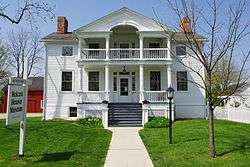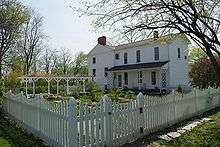Hull–Wolcott House
|
Hull–Wolcott House | |
 Front of the house | |
  | |
| Location |
1031 River Road Maumee, Ohio |
|---|---|
| Coordinates | 41°34′20″N 83°38′21″W / 41.57222°N 83.63917°WCoordinates: 41°34′20″N 83°38′21″W / 41.57222°N 83.63917°W |
| Area | 1 acre (0.40 ha) |
| Built | 1827 |
| Architect | James A. Wolcott |
| Architectural style | Federal |
| NRHP Reference # | 70000506[1] |
| Added to NRHP | January 26, 1970 |
Named for James Wolcott, a prosperous businessman during the late 1820s to the mid 1840s, only the Wolcott House is original to the site. Built by James Wolcott and his wife, Mary Wells, the Wolcott House began as a log house and evolved into a beautiful 14-room Federal-style mansion between the years 1827 and 1836.
Maumee, the Foot of the Rapids of the Maumee River, was an important transshipment point serving Indian, French, English and American traders throughout the 19th century. The Battle of Fallen Timbers in 1795 secured the Northwest Territory for the settlement, and a lively river trade developed in the years following the War of 1812.
A proposed canal to connect Lake Erie with Fort Wayne stimulated speculative interest and attracted Eastern entrepreneurs. Among the earliest emigrants was James Wolcott of Connecticut. Wolcott traveled to Missouri, where he met and married Mary Wells. Mary Wells Wolcott was the daughter of William Wells and his wife Sweet Breeze who was the granddaughter of the great Miami Chief Little Turtle . William Wells was kidnapped at age 12 by the Miami Indians near his Kentucky home, was adopted by Chief Little Turtle and fought alongside the Indians during the Indian Wars, 1790-1794. He later went over to the Americans to serve with General Anthony Wayne. He was present at Wayne's victory at the Battle of Fallen Timbers in 1794 and served as the interpreter for the Miami at the Treaty of Greenville in 1795. Wells was killed during the Fort Dearborn massacre in 1812.
Reports of the growing commercial opportunities at the Foot of the Rapids prompted James and Mary to travel to Maumee in 1826. They purchased 300 acres for $1.25 an acre in 1827 and began construction of their handsome home. The house is a blend of federal and classic architecture. Wolcott built wharves and warehouses on the Maumee River just below his home and constructed two steamships - the General Harrison and the James Wolcott - to transport his merchandise. By 1837, Wolcott's retail and wholesale businesses were booming and his fortune increased with the completion of the Wabash and Erie Canals.
Mary's Native American heritage prompted her kindness, understanding and sympathy toward the Native Americans of the Maumee Valley as they were slowly driven from their lands. She was known for her incredible hospitality toward both Indians and white settlers to the area.
James and Mary Wolcott had five sons and a daughter. Their home passed through three generations to Wolcott's great-granddaughter, Rilla Hull, who was the last of the Wolcott line to reside in the "Mansion on the Maumee". She cherished the heritage of her ancestors and the broader history of the lower Maumee Valley and took an active role in preserving local sites such as Fort Miamis. Upon her death in 1957, Ms. Hull bequeathed her home for public use and benefit. St. Paul's Episcopal Church transferred the landmark to the City of Maumee for use as a historical museum.
Home Ownership: James and Mary Wolcott – b.1789 to d.1873, Mary Ann Wolcott Gilbert – b.1827 to d.1891, Fredrica Gilbert Hull – b.1850 to d.1934, and Rilla E. Hull – b.1880 to d.1957.[2]
Wolcott House Museum Complex
Today the Hull–Wolcott House is part of the Wolcott House Museum Complex, which is owned by the city of Maumee and run by the Maumee Valley Historical Society. The complex consists of the following structures:
- The Wolcott House, ca. 1835



- The Log House, ca. 1850
- The Gilbert-Flanigan House, ca. 1841
- The Box Schoolhouse, ca. 1850
- The Clover Leaf Depot, ca. 1888
- The Monclova Country Church, ca. 1901

Maumee Valley Historical Society
The roots of the Maumee Valley Historical Society go back to 1864 with the formation of the Maumee Valley Pioneer Association. The founding members were early settlers of Northwest Ohio who came together to protect and preserve the historic artifacts of the Maumee Valley as well as to document information about themselves for future generations.
Peter Navarre was the first president of the Society and served until his death in 1873. Horatio Conant served as Vice-President. The first meeting was held in Toledo on February 22, 1865, with Morrison R. Waite of Maumee City, Ohio, as the guest speaker.
In 1918, the Society became known as the Historical Society of Northwest Ohio. The object of the Society was to: 1)acquire books, printed papers, and manuscripts. 2)encourage writing of books and papers. 3)deliver lectures and addresses on subjects of history. 4)collect and arrange objects of historical interest and provide for their preservation and exhibition. 5)provide a museum to house these collections.
The purpose of the Historical Society broadened in the late 1950s when its dream of operating a museum became a reality. In 1957 Rilla Hull, the last direct descendent of James and Mary Wolcott, died bequeathing her ancestral home to St. Paul's Episcopal Church of Maumee. The church sold the estate to the City of Maumee and is managed by the Maumee Valley Historical Society.
The mission of the Maumee Valley Historical Society is to collect, preserve, study, interpret and communicate the history and culture of the Maumee Valley for the public. This mission is accomplished through a variety of educational programs, events and projects, which are presented within the context of an early nineteenth to early twentieth century recreated village around a central green on the grounds of the Wolcott House, using period structures containing appropriate furnishings and artifacts.
References
- ↑ National Park Service (2009-03-13). "National Register Information System". National Register of Historic Places. National Park Service.
- ↑ http://www.wolcotthouse.org
External links
- Website of the Wolcott House Museum Complex
- "National Register Of Historic Places, Lucas County, OH"